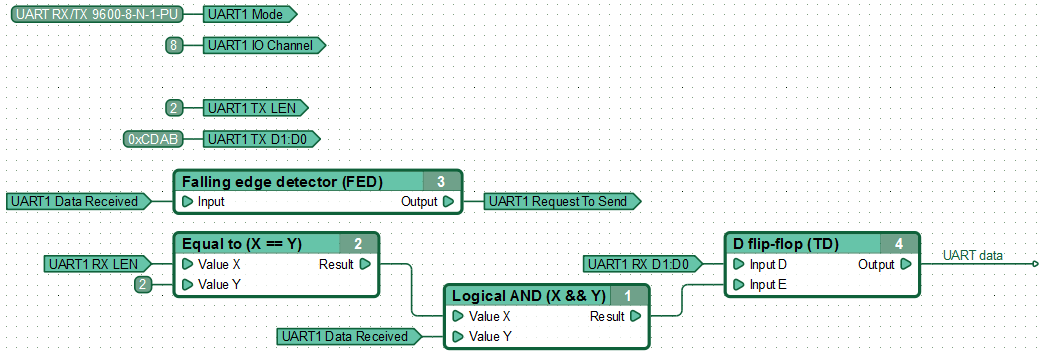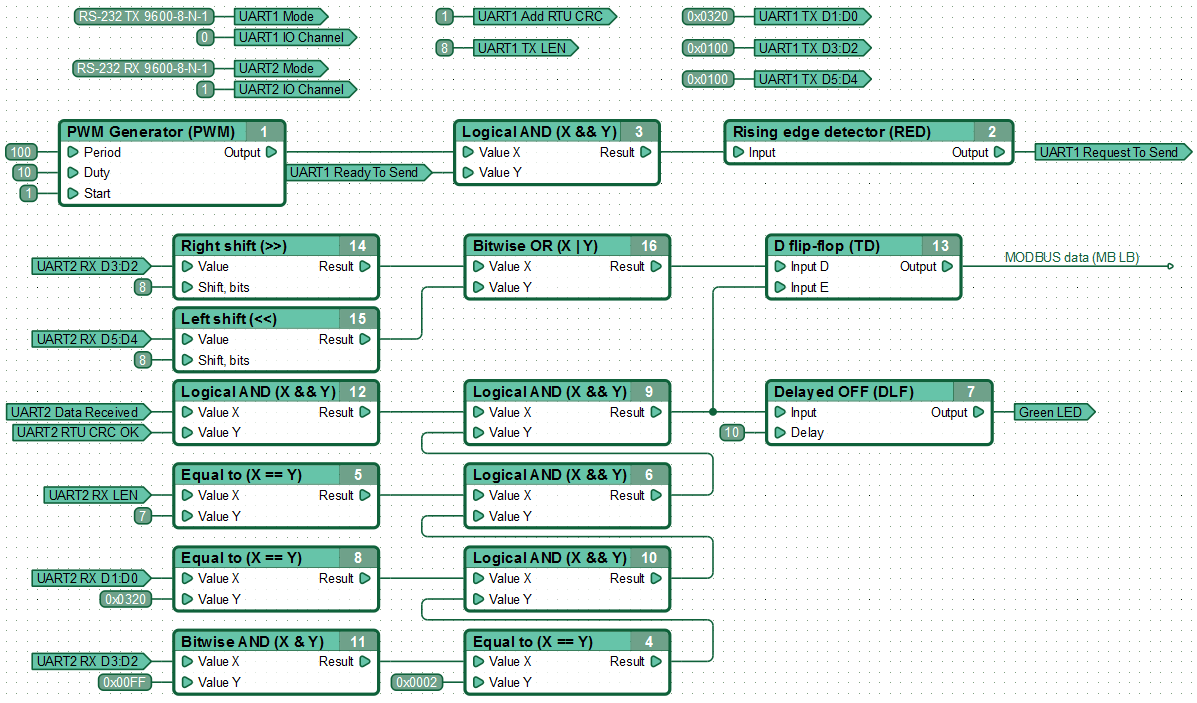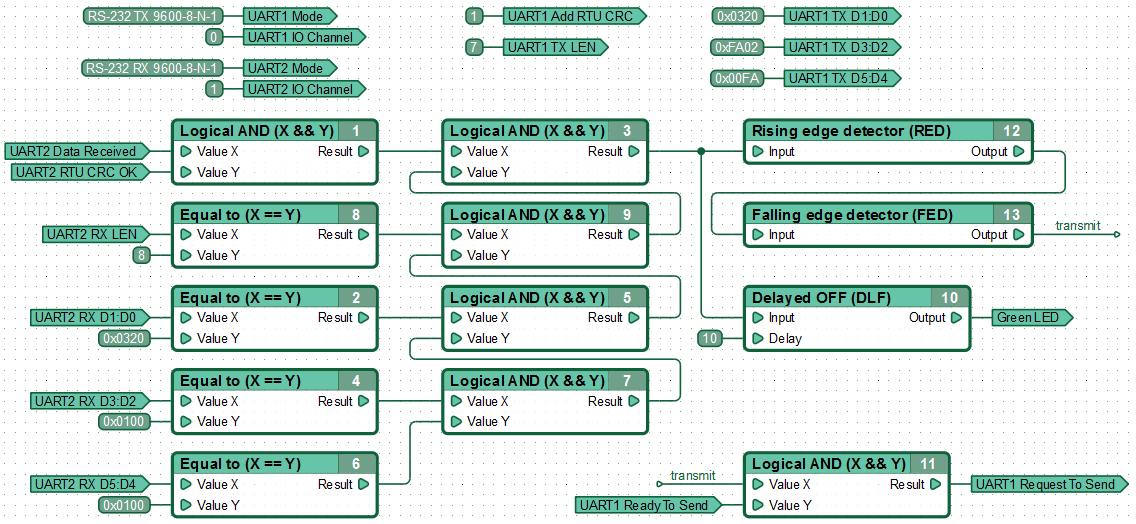CANNY 7.2 Duo. UART Driver
- General Description
- Drivers registers
- Controller operation in UART mode
- Controller operation in RS-232 mode
- Modbus RTU implementation
- Controller operation in USB VCP mode
General Description
Up to four of the nine CANNY 7.2 Duo input-output channels can be used to set up data transmission/reception through UART and RS-232-compatible serial protocols. It may be used to connect the controllers with each other or with external equipment supporting this communications protocols. The channels may be activated independently of each other and have individual data speed setting, protocol type and configuration, pull up line. Four UART interfaces capable of working in half-duplex mode, lets you set up two interfaces working in full duplex mode if necessary.
The UART2 interface additionally provides a mode of operation as USB Virtual COM-port (VCP), which allows you to connect the controller to external devices, for example, to a PC, using the miniUSB connector on its board and exchange data with them during operation custom chart. Data exchange takes place in full duplex mode, i.e. it is possible to simultaneously send and receive data.
Size of receive and transmit buffers for each of the interfaces of the CANNY 7.2 Duo UART driver is 64 bytes.
UART implementation in CANNY 7.2 Duo controllers enables serial data reception and transmission over a single wire in half-duplex mode. Thus CANNY 7.2 Duo may have four independent connections when using the UART protocol. Monitoring of the data link status is done from the function diagram. If the channel is free, the device may start data transmission , otherwise the device should wait for the line release.
RS-232-compatible implementation, using any two UART data channels, enables the exchange of data with other RS-232 devices in duplex mode, i.e. one channel is used to send data, while the other is used to simultaneously receive data. By using two pairs of UART channels it is possible to set up two independent duplex RS-232 connections
Modbus protocol in CANNY 7.2 Duo controllers is implemented both over UART or over RS-232. A compact binary variant called Modbus RTU is used as the ADU (Application Data Unit). Checking the data integrity is done via the automatically calculated checksum (CRC). Package size is limited to 64 bytes including the CRC.
Note: For the correct operation of all protocols based on the UART, all GND terminals of all devices within the same UART network, need to be given to a single potential (“common ground”).
Note: In UART implementation: the active line is the GND 100mA potential, the passive line is the positive potential of a given internal or external channel pull-up. In implementing RS-232-compatible - the potentials are inverted.
UART / Modbus driver operates using the controller’s channel resources, but has a higher priority than the discrete input-output driver. This means that for all channels, for which the UART/Modbus driver is activated, all value changes in registers associated with discrete input-output driver will be ignored.
ATTENTION! The Dallas 1-Wire driver uses the resources of the UART1 driver for its work. It is not possible to use Dallas 1-Wire and UART1 drivers at the same time.
Drivers registers
The following table describes the expected values for driver configuration registers.
| Register | Expected values |
|---|---|
| UARTx Mode Setup Register | 1…N = set controller channel configuration, which determines the current operation mode and applicable parameters (defined by a named constant from the named constants list); 0 = disconnect the channel from UARTx driver, return channel control to the discrete IO driver and allow the channel’s status to be changed from the function diagram. |
| UARTx Receive Timeout Setup Register, bits | 1…255 = stop data reception, if, during the time for which the specified number of data bits could be received, line did not detect any potential changes and was in a passive state; 0 = use the default value defined in channel (13) configuration. |
| UARTx IO Channel Select Register | 0…8 = transfer the specified input-output channel under the control of the UARTx driver; use the specified input-output channel to work with the corresponding UARTx interface. |
| UART2 VCP Mode Enable | ≥ 1 = activate the VCP Mode of the UART2 interface; 0 = deactivate the VCP Mode of the UART2 interface. |
Note: When a channel is operating in UART mode, it can be used for both transmitting (TX) and receiving (RX) data. This UART interface must operate in half-duplex mode.
UART driver configuration is determined by constants that represent a combination of parameters that determine the speed, mode, additional data transmission parameters and line potential in passive mode.
| Parameter | Permitted Values |
|---|---|
| The data rate, bps | 110; 150; 300; 600; 1200; 1800; 2400; 4800; 9600; 19200; 38400; 57600 |
| Mode | UART; inverted UART; USB VCP (UART2 only) |
| Pull-up in UART mode | pulled up; float (open collector) |
| The transfer direction in RS-232 mode | receive; transmit |
| Data bits | 8; 9 |
| parity | N (no) ; O (odd) ; E (even) |
| Number of stop bits | 1; 2 |
Named constants that represent a combination of UART configuration paremeters are available in the “UART modes” folder of the CannyLab named constants list.
| Register | Return values |
|---|---|
| UARTx Overflow Register | 1 = UART buffer is full; 0 = no overflow detected. |
| UART2 VCP Connected Register | 1 = connection of the controller with an external device via USB VCP of the UART2 interface is established; 0 = сconnection of the controller with an external device via USB VCP of the UART2 interface is not established. |
| UARTx Receive Error Register | 1 = an error occurred during UART data reception; 0 = the driver is operating normally. |
| UARTx Ready To Send Register | 1 = UART driver data transmit buffer is free; 0 = UART driver data transmit buffer is busy, data transmission is not possible. |
| Register | Expected values |
|---|---|
| UARTx Data Set Ready Register | 1 = a message was received and placed into the respective UART channel’s receive buffer; 0 = no actual data is present in the respective UART channel’s receive buffer. |
| UARTx RTU Received Register | 1 = the received message on the respective UART channel is a valid Modbus RTU message, its checksum is correct; 0 = the received message on the respective UART channel is not a valid Modbus RTU message. |
| UARTx Received Data Length Register | 0…64 = value equal to the number of data bytes in the packet received via the respective UART channel |
| UARTx Received Data Register D1:D0 … UARTx Received Data Register D63:D62 |
0…0xFFFF = data byte values corresponding to UART reception buffers of the respective channel, two bytes per register |
| Register | Expected values |
|---|---|
| UARTx Request To Send Register | ≥ 1 = load data from the transmit registers into the respective channel’s UART transmit buffer; 0 = do not load data into the respective channel UART transmit buffer. |
| UARTx RTU Transmit Register | ≥ 1 = command the driver to add the checksum in Modbus RTU format to the message in the respective channel’s UART driver transmit buffer. This forms a data packet compliant to the Modbus RTU protocol; 0 = transmit data from the respective channel’s UART driver transmit buffer “as is”. |
| UARTx Transmit Data Length Register | 0…64 = the number of data bytes that will be transmitted over the line, when receiving a command to send on the respective channel’s UART driver |
| UARTx Transmit Data Register D1:D0 … UARTx Transmit Data Register D64:D62 |
0…0xFFFF = values of data bytes for transmission via respective UART driver channel, corresponding to data bytes that will be written to the transmit buffer. Two bytes per register. |
While working in Modbus mode, the UARTx Received Data Length Register contains the value that accounts for the received CRC checksum bytes, i.e. the value stored within the register is 2 bytes longer than the actual message length without the checksum. When sending a Modbus packet, the Transmit Data Length Register also needs to be set to a value 2 bytes longer than the message length, enabling you to add and transmit the CRC checksum. This means that the maximum packet length for Modbus messages is 64 bytes including CRC.
Controller operation in UART mode
Operating in UART mode, the controller can perform half-duplex data transmission/reception on a single wire. Below is an example illustrating how UART mode could be used in your function diagrams.

The controller receives a message via the UART1 interface. If the message is 2 bytes in length, it saves it into the corresponding named network for further processing, and on the next cycle of the diagram execution sends 2 prepared bytes of data back.
Note: Particular attention must be paid to the fact that in order to avoid collisions while sending data, you need to constantly monitor the send buffer by checking the UARTx Ready to Send Register: if the buffer is not ready, then the driver is currently receiving data and transmitting data should be postponed until the buffer is ready.
Controller operation in RS-232-compatible mode
Operating on the RS-232-compatible protocol the controller can use each of its data transfer channels only in simplex (unidirectional) mode. When using both UART channels, which operate independently of each other, it is possible to organize a full-duplex mode of data transmission via two wires: one channel being used only for reception, the other only for transmission.
Below is an example of a function diagram implementing the RS-232-compatible mode. Data is received through UART2 and the value of bytes D1:D0 is compared to 0xAAAA. If the values are equal to 0xAAAA, the controller sends 2 bytes of data containing the value 0xBBBB over UART1.

Modbus RTU implementation
UART/Modbus driver includes functionality that lets it automatically create and verify the checksum using the Modbus RTU standard, which simplifies inclusion of the controller into a network operating under the Modbus RTU protocol. You can manage checksum formation for messages to be transmitted and checksum verification at reception by accessing the appropriate driver registers.
Note: While working in Modbus mode, the UARTx Received Data Length Register contains the value that accounts for the received CRC checksum bytes, i.e. the value stored within the register is 2 bytes longer than the actual message length without the checksum. When sending a Modbus packet, the Transmit Data Length Register also needs to be set to a value 2 bytes longer than the message length, enabling you to add and transmit the CRC checksum. This means that the maximum packet length for Modbus messages is 64 bytes including CRC.
Example of the controller operating in Modbus MASTER-node mode over RS-232-compatible mode

The controller periodically requests a SLAVE-node with address 0x20 to send the value of the Modbus-data register with address 0x0001. The controller flashes the green LED once when it receives an acknowledgment of this request.
The query string during data exchange between these devices will look like this:
-> 20 03 00 01 00 01 D3 7B
Explanation:
Polled device address: 0x20 (D0 byte of UART2 receive data register D1:D0);
Function: 0x03 - reading values from multiple holding registers (D1 byte of UART2 receive data register D1:D0);
Number of the first requested register: 0x0001 (D2 and D3 bytes of UART2 receive data register D3:D2);
Number of requested registers: 0x0001 (D4 and D5 bytes of UART2 receive data register D5:D4);
Checksum: 0xD37B (D6 and D7 bytes of UART2 receive data register D7:D6 — the driver adds this automatically).
Example of the controller operating in Modbus SLAVE-node mode over RS-232-compatible mode

The controller receives a request for data transmission from a MASTER-node and sends back the state of the requested register. It transmits 2 bytes of data (Modbus registers are 16 bits) and 2 CRC bytes.
Receiving a request for data transmission from MASTER, the controller sends back the requested register state. Controller transmits 2 byte of data (+2 CRC bytes), as Modbus registers are 16 bits.
A response string during data exchange between the devices will look like:
<- 20 03 02 00 10 C6 A0
Explanation:
Responding device address: 0x20 (D0 byte of UART1 transmit data register D1:D0);
Function: 0x03 - the result of reading the values from several holding registers (D1 byte of UART1 transmit data register D1:D0);
The number of returned bytes: 0x02 (D2 byte of UART1 transmit data register D3:D2);
The value of the upper byte of the requested register: 0x00 (D3 byte of UART1 transmit data register D3:D2);
The value of the least significant bit of the requested register: 0x10 (D4 byte of UART1 transmit data register D5:D4);
Checksum: 0xC6A0 (D5 byte of UART1 transmit data register D5:D4 and D6 byte of UART1 transmit data register D7:D6 respectively — driver adds this automatically).
Controller operation in USB VCP mode
The UART driver, working in USB VCP mode, allows the controller to establish a connection with external devices for data exchange using the miniUSB connector of the controller. There is no need to set data exchange parameters in this mode. Connection settings can be configured on an external device. Data exchange is possible at the maximum speed that Virtual COM-port can provide.
An example of a functional diagram of the controller in USB VCP mode. Receiving on UART2 6 bytes of data containing the message “Hello!” (in ASCII format), the controller sends 3 bytes containing the message “Hi!”. The controller confirms the connection to an external device by turning on the red built-in LED. Receiving a message from an external device is indicated by a short-term activation of the green built-in LED.


